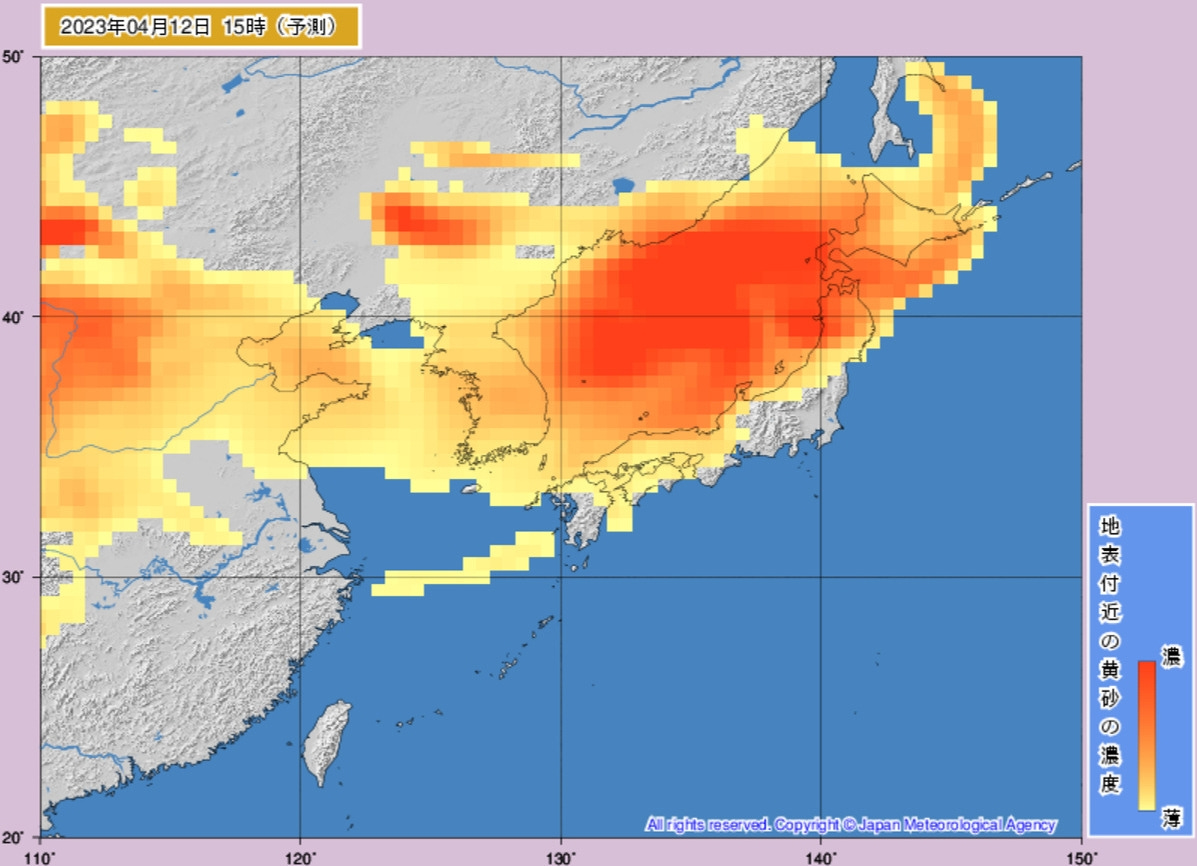Yellow “Asian Dust” (real dust) Covers Japan
This seasonal weather event seems to be getting worse due to global warming while simultaneously acting as a major cause of increasing temperatures worldwide.

What’s new: It’s that time of the year again when Japan becomes blanked in a huge swathe of ultra-fine particulate of yellow sand. It is a nation-wide phenomenon that occurs every spring in which large amounts of dust (sand and dirt) blown up by strong winds from the deserts of East Asia (Gobi Desert, Taklamakan Desert, etc.) and loess areas are carried by the winds in the sky and subsequently float down across the country. This weather event is called kosa (黄砂) in Japanese. The term loosely translates as “Asian dust,” and this year it has become particularly noticeable from this week.
Why it matters: Asian dust causes the sky to turn yellowish-brown and smoky. According to Japan’s Ministry of the Environment, which has published a report on the effects of Asian dust on human health on its website, common symptoms of prolonged exposure include itchy eyes, conjunctivitis, allergic symptoms such as runny nose and sneezing, and worsening of respiratory diseases such as bronchial asthma and pneumonia.

Hospitalizations for bronchial asthma caused by Asian dust are particularly severe for children and the elderly, according to the report.
“Allergic symptoms are common. When Asian dust is airborne people complain of skin irritation. We know that Asian dust also irritates mucous membranes through the respiratory tract, and pollen and air pollutants also come in and make it worse."— Dr. Kazunari Onishi, M.D., Graduate School of Public Health, Support Unit for Conducting Clinically Essential Studies, St.Luke’s International University, Tokyo (http://issey.work/1439/1440/16030.html)
Asian dust not only makes the sky hazy, but it also has a wide range of effects on aircraft takeoffs and landings, human health, and, more recently, on solar panels used for photovoltaic power generation. It is regarded as a serious weather disaster worldwide. Another important factor is its impact on global warming.
Go deeper: The occurrence or non-occurrence of Asian dust and the amount of yellow sand particles are greatly influenced by the conditions of the ground surface (vegetation, snow cover, soil moisture, soil particle size, etc.) and winds overhead, in addition to the degree of strong winds in the area where the phenomenon occurs. Once Asian dust particles become airborne, relatively large particles (10 micrometers or larger in diameter) fall quickly due to gravity, while smaller particles (several micrometers or smaller in diameter) are carried farther by the winds above. For example, it has been reported that yellow sand particles originating in East Asia were transported across the Pacific Ocean to North America and even as far as Greenland.

Threat level. In order to prevent health effects of Asian dust, it is recommended that everyone, especially those with respiratory or circulatory problems, children, and the elderly, limit their exposure. The Japanese government is currently encouraging everyone in Japan to reduce the amount of Asian dust they inhale by avoiding unnecessary trips outside and wearing non-woven masks.
What’s next. The season for Asian dust lasts from February through May. Thus, we are right in the thick of it—so to speak—right now. The good news is that, at least as far as 2023 is concerned, relief is in sight.
The bad news is that there is a growing body of evidence to suggest that a viscious cycle has emerged to cause increasing levels of Asian dust due to global warming. In turn larger levels of Asian dust are, apparently, exacerbating global warming. Researchers from the National Oceanic and Atmospheric Administration (NOAA) point out that
In order to more accurately predict future climate, we need to understand more about how dust and dirt in the atmosphere is involved in cloud formation. Rapid climate change is resulting in frequent and violent dust storms in areas where desertification is occurring. Asian dust is now on the verge of moving from being merely a haze in the sky to becoming a major contributor to weather disasters and even global warming.
Links to Japanese Sources: https://www.data.jma.go.jp/gmd/env/kosahp/4-4kosa.html, https://www.nhk.or.jp/shutoken/newsup/20230412b.html, and https://news.yahoo.co.jp/byline/katayamayukiko/20220304-00284937.
#Asiandust #yellowsandphenomenon #yellowsand #黄砂 #ゴビ砂漠 #タクラマカン砂漠





Wow, Pam, I did not know that about Florida! Interesting article, Mark, as always. I thought red tide was bad enough….
We have gotten Asian dust in Sarasota, Florida! Pam Baran